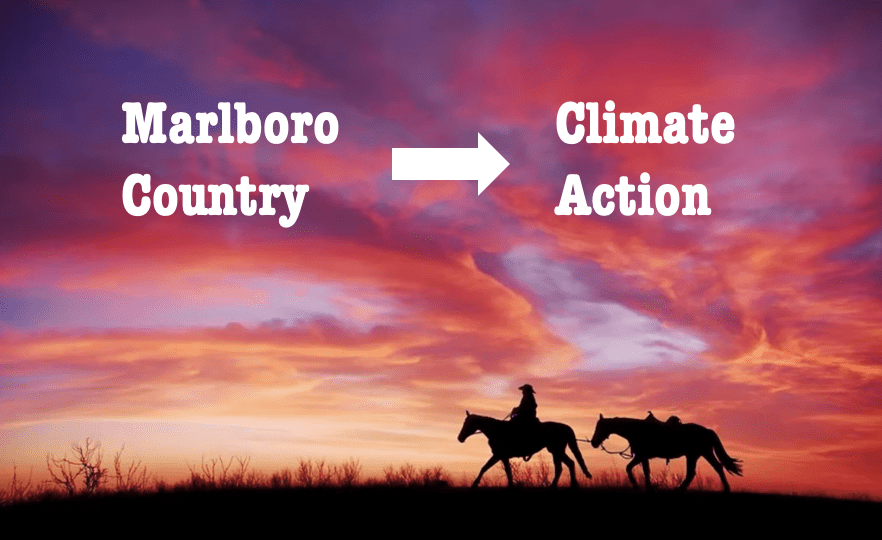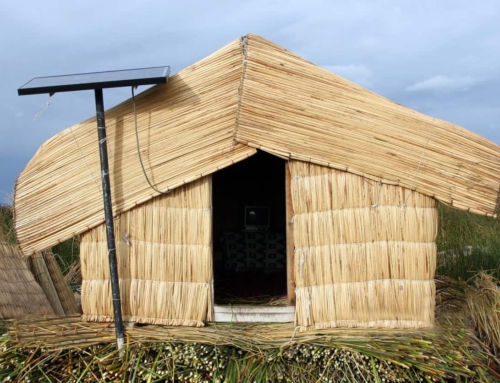In the late 1950s, Phillip Morris & Co. hired Leo Burnett Advertising to change the image of their feminine filtered cigarettes to make them more masculine. Filtered cigarettes were a technical ruse. They were supposed to be healthier and were mostly smoked by women. Burnett launched one of history’s most successful advertising campaigns…The Marlboro Man. It was based on creating an identity embodied in the masculinity of the mythological west. In a matter of years, the sales increased 300%.
There is a lesson here for climate communicators.
If we can take a horse, a cowboy and the theme from the Magnificent Seven and sell billions of dollars of cigarettes that kill us, why can’t we do a better job of creating climate action? Or perhaps asking it differently, why can’t we attract people for the noble cause of saving ourselves and others?
We know that climate action starts with personal commitment whether this is reflected in individual action or individual action leveraged as collective political action. We know that rational consideration of costs and benefits has only a minor impact on whether a person acts. Think about the success of the smoking campaign by R.J. Reynolds. Why is this? Because humans are a collection of contradictions and biases. Beliefs, emotions, and identification with social groups are the biggest influencers of individual action.
The PR firms that fossil fuel companies hire know this and have learned their lessons from tobacco companies. They have the same issues, they use the same techniques of denial, doubt, and disinformation. They plow hundreds of millions into PR campaigns. They have been wildly successful. More about their efforts here.
The one lesson they understand is that people can’t be persuaded, they need to be attracted. They want to imagine a better version of themselves in the future. That who they are (their identity) drives action or, in many cases, consumerism.
The opposition also understands something that the climate movement doesn’t. That facts and reasons don’t work. They are a form of persuasion. Yet, the climate movement continues to fail by trying to convince or persuade people that climate change is real. We believe that if we can just show people how climate change will kill us (doomerism), then logically, we will take climate action. Just try quitting smoking. The facts don’t help much. This approach hasn’t worked for thirty years, and we can’t keep doing the same thing for the next thirty.
The primary question I wished every climate communicator asked is, “How can we build climate identity?”
Or “How can we create an identity that attracts others so we can move to climate action? How can we make them feel like they are valuable, important, and are already just like us?”
On Maslow’s hierarchy of needs, love and belonging rank just after our physical and safety needs as humans. Indeed many argue that they are more important. What would you do to protect your family?
That sense of belonging can been seen in many social movements. Sometimes for good and sometimes for malevolence. One example for good is the dedication of healthcare workers during the pandemic. What caused them to spent countless hours, risking their lives in the face of a deadly disease trying to save others? It was their empathy for others and a sense of identity as healers. All around my neighborhood, which is next to a hospital system, signs sprouted up saying, “Thank you healthcare workers. We love you.” This reinforced their identity and efforts.
Another example is the MAGA movement. In this case, their identity overcomes rational thought or facts. Witness the anti-masking campaigns. Political position doesn’t determine identity. i.e. I support lower taxes, therefore I am a Republican. Identity precedes political issues and determines ones position. i.e. I am Republican, therefore I am against masks. Ridiculing them for their beliefs or trying to reason with them doesn’t work. It actually has the opposite effect.
A sense of belonging can extend to knitting circles or even consumer groups. Think Marlboro gear groups or Corvette clubs where people identify and amplify consumer brands. They are saying, this is who I am.
How do we build identity? There are many ways to do this.
For example, when was the last time your climate campaign featured a climate hero? It would be great to see climate campaigns occasionally focus on those fighting for the cause, rather than explaining why the cause is worth fighting for. The first approach is based on attraction, the second is based on persuasion. The fault in our thinking is that one must first understand the facts before making a rational decision to join a cause. The millions of youth marching with Greta Thunberg before the pandemic had only a high level understanding of climate, but they marched for those beside them and for Greta. Greta Thunberg was their hero. We will know we’ve accomplished attraction when our kids grow up and say, “I want to be like Greta Thunberg.”
Heroes are a part of storytelling. Our stories help promote our values and our values connect others to us. Thus creating an identity. We need fewer fact sheets and more stories.
One of the shortest stories we can tell is with framing. We are constantly bombarded with frames from the fossil fuel industry that limit our thinking and frame our choices. An example of the fossil fuel industry framing something bad as good is natural gas? The word natural makes it seem innocuous. An example of taking a good thing and making it better is clean renewable energy. The word clean frames energy as does renewable.
The image of the cowboy in the Marlboro ads is a visual frame. A dangerous one, since it links the very addictive substance nicotine, to a self image and identity. And perhaps some of the best frames do a similar thing to our brains. Give us a little shot of dopamine.
Framing is too big a tool to cover in one post, but you can learn more here and here. We can create identity through better framing.
Another way is to focus on campaigns that bring people into the movement. The rather clinical word for this is onboarding. What is the person interested in? What brought them to your door? What skills do they have? How can we inspire them? Are we giving them significant jobs to do? Are we listening to them? And lastly, are we thanking them for what they do? Too many times people are attracted to a cause or grassroots organization and then drop off the radar after a month or two because they didn’t see or feel a way they were valued. Their identity wasn’t reinforced.
Identity building can also be based on an “us versus them” model. It is a tenet of fundamentalism to create an enemy outside of your core group to increase the solidarity of the group. Sometimes these are real, and sometimes they are imaginary. We don’t need to become fundamentalists. But we do need to be specific about the opposition. Just like the word climate is vague, so are terms like fossil fuels, corporations, government so we can be more specific. Who is violating our group values and why?
To grow past a small group into a significant movement we also need to also identify our vision. That vision must encompass not just our climate solutions, but our vision of the identity of our group based on our values. An example is referring to pipeline resistance using the frame water protection or water protectors.
Another way is through visibility. The pandemic has forced the climate movement to restrict their public presence. We need to get back to our public demonstrations. Facebook and emails aren’t going to move us fast enough or attract others. Nothing moves us toward identity faster than seeing others take visible action. Visibility provides an example of social proof and inevitability. It reinforces identity.
We don’t need to promote the toxic image of the lonely cowboy to create identity. But we do need to understand why people are attracted to that image. As we think about our next campaigns, let’s think about how we will rely less on facts and reasons, and more about creating a campaign that builds an identity and attracts people.
Thanks for what you do.
PS: If you’ve read this far and not asked a key question, the next question we ought to be asking is what identity do we want to create? The Marlboro man is a symbol of dominant masculinity. The narrative that strong men can control and overcome issues like the climate crisis hasn’t worked. For me it is doubtful that we will succeed just by changing the focus of our domination from money, power, and inter-governmental competition to trying to control the climate. It will require another type of change. A change in values and actions towards each other. While we do need to work on climate for our survival, the change required is an internal one. How do we treat and help each other. This will be more difficult than solving climate change itself.
Hobie,
‘We are all connected. Savor the Earth!’™
L. Hobart Stocking
SkyWaterEarth.com
hobart@skywaterearth.com
651-357-0110
Facebook: @SkyWaterEarthConnected
Twitter: @SkyWaterEarth








Leave A Comment